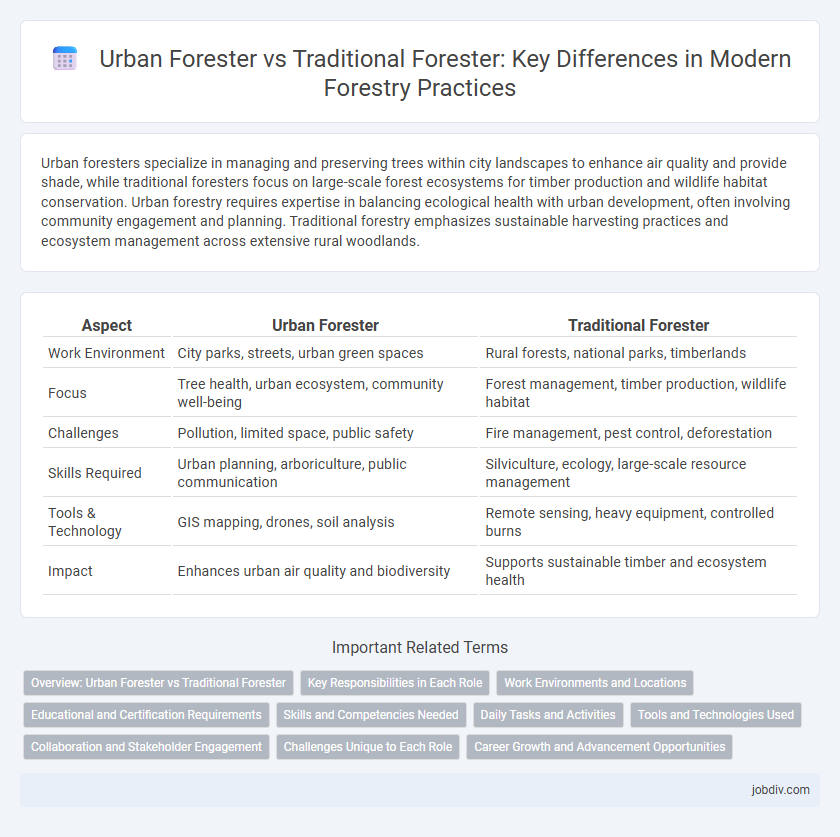Urban foresters specialize in managing and preserving trees within city landscapes to enhance air quality and provide shade, while traditional foresters focus on large-scale forest ecosystems for timber production and wildlife habitat conservation. Urban forestry requires expertise in balancing ecological health with urban development, often involving community engagement and planning. Traditional forestry emphasizes sustainable harvesting practices and ecosystem management across extensive rural woodlands.
Table of Comparison
| Aspect | Urban Forester | Traditional Forester |
|---|---|---|
| Work Environment | City parks, streets, urban green spaces | Rural forests, national parks, timberlands |
| Focus | Tree health, urban ecosystem, community well-being | Forest management, timber production, wildlife habitat |
| Challenges | Pollution, limited space, public safety | Fire management, pest control, deforestation |
| Skills Required | Urban planning, arboriculture, public communication | Silviculture, ecology, large-scale resource management |
| Tools & Technology | GIS mapping, drones, soil analysis | Remote sensing, heavy equipment, controlled burns |
| Impact | Enhances urban air quality and biodiversity | Supports sustainable timber and ecosystem health |
Overview: Urban Forester vs Traditional Forester
Urban foresters specialize in managing and conserving trees within city landscapes to enhance environmental quality, public health, and urban aesthetics. Traditional foresters focus on the sustainable management of forest ecosystems, emphasizing timber production, biodiversity, and habitat conservation in rural and wilderness areas. Both roles require expertise in tree biology and ecology but differ significantly in their application environments and management objectives.
Key Responsibilities in Each Role
Urban Foresters specialize in managing trees within city environments, focusing on planting, maintaining, and protecting urban tree canopies to enhance air quality, reduce heat, and improve community well-being. Traditional Foresters concentrate on managing large forested areas, emphasizing timber production, wildlife habitat conservation, and sustainable forest management practices to maintain ecosystem health. Both roles require expertise in tree biology and ecology, but Urban Foresters prioritize human interaction and urban planning, while Traditional Foresters focus on large-scale forestry operations and natural resource preservation.
Work Environments and Locations
Urban foresters manage trees and green spaces within cities, working in parks, streetscapes, and urban forests to enhance air quality and community well-being. Traditional foresters operate primarily in rural or wilderness areas, overseeing timber production and ecosystem health across national forests and private woodlands. Both roles require knowledge of tree biology and environmental science, but urban foresters emphasize human interaction and urban planning, while traditional foresters focus on large-scale forest management and conservation.
Educational and Certification Requirements
Urban Foresters typically require a bachelor's degree in urban forestry, environmental science, or a related field, with specialized training in community engagement, urban ecology, and green infrastructure. Traditional Foresters often hold degrees in forestry, natural resource management, or environmental science, emphasizing silviculture, forest ecology, and timber management. Certification for Urban Foresters frequently includes credentials like the Society of American Foresters' Certified Arborist or Certified Urban Forester, while Traditional Foresters commonly pursue the Registered Professional Forester (RPF) credential to demonstrate expertise and professional standards.
Skills and Competencies Needed
Urban foresters require expertise in urban planning, community engagement, and knowledge of diverse tree species resilient to city environments. Traditional foresters must have strong skills in forest ecology, timber management, and wildfire prevention techniques. Both roles demand proficiency in GIS technology, tree health assessment, and sustainable forestry practices.
Daily Tasks and Activities
Urban foresters manage tree planting, maintenance, and health assessments in city parks and streets, addressing challenges like pollution and soil compaction. Traditional foresters focus on timber harvesting, fire management, and ecosystem conservation across large forest landscapes. Both roles involve monitoring tree growth and pest control but differ in scale and stakeholder engagement.
Tools and Technologies Used
Urban foresters utilize advanced GIS mapping, remote sensing technologies, and tree inventory software to manage green spaces within densely populated areas, enhancing precision in tree health monitoring and urban planning. Traditional foresters rely on GPS devices, aerial surveys, and timber cruising equipment to assess forest composition and timber volume across extensive, often rural, landscapes. Both roles increasingly integrate drones and mobile applications, but urban foresters prioritize tech solutions tailored for complex urban ecosystems and infrastructure interactions.
Collaboration and Stakeholder Engagement
Urban foresters collaborate extensively with community members, local governments, and public agencies to integrate green spaces into city planning, emphasizing stakeholder engagement for sustainable urban ecosystems. Traditional foresters primarily work with timber companies, conservation groups, and government agencies to manage forest resources for economic, ecological, and recreational purposes. Both roles require strong communication and coordination skills to balance diverse stakeholder interests and promote forest health.
Challenges Unique to Each Role
Urban foresters face challenges such as managing limited green spaces, mitigating pollution impacts, and addressing diverse stakeholder interests in densely populated areas. Traditional foresters encounter difficulties related to large-scale forest management, wildfire control, and maintaining biodiversity across extensive natural landscapes. Both roles require adaptive strategies, but urban forestry emphasizes social and environmental justice, while traditional forestry prioritizes ecosystem conservation and resource sustainability.
Career Growth and Advancement Opportunities
Urban foresters specialize in managing and enhancing green spaces within cities, offering diverse career paths in municipal planning, environmental consulting, and community engagement. Traditional foresters typically work in rural or wilderness areas, focusing on timber production, forest conservation, and wildlife management, with advancement often tied to government agencies or private forestry firms. Urban forestry careers show increasing demand due to growing urbanization and environmental awareness, providing expanding opportunities for leadership roles and interdisciplinary collaboration.
Urban Forester vs Traditional Forester Infographic

 jobdiv.com
jobdiv.com